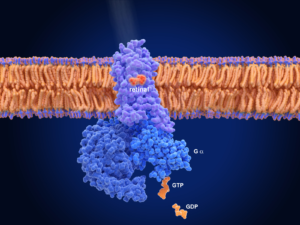
Researchers at the University of California, Irvine (UCI) have made a groundbreaking discovery that could potentially lead to a treatment for retinitis pigmentosa, an inherited eye disease that affects the retina’s rod photoreceptor cells. The team discovered a special antibody that can halt rhodopsin photoactivation, which is a light-sensing molecule in the retina.
The researchers used a llama-derived antibody, known as a nanobody, to investigate rhodopsin at high resolution. They found that the nanobodies targeted an unexpected site on the rhodopsin molecule, which is different from the site targeted by existing treatments. This discovery is significant because it opens up new possibilities for targeted gene therapies.
Moreover, the researchers found that the stabilizing effect of these nanobodies can also be applied to rhodopsin mutants associated with retinal disease, suggesting their use as therapeutics. This means that the antibody has the potential to treat a wide range of retinal diseases caused by rhodopsin mutations.

According to Krzysztof Palczewski, Ph.D., UCI School of Medicine, and senior author of the report, published in Nature Communications, “More than 150 mutations in rhodopsin can cause retinitis pigmentosa, making it challenging to develop targeted gene therapies.” The discovery of the nanobody offers hope for a new treatment approach that could potentially address these mutations.
The discovery is also significant because it highlights the potential of nanobodies as therapeutic agents. Nanobodies are small, single-domain antibodies that are derived from heavy-chain antibodies found in camelid animals such as llamas and camels. They have gained popularity in recent years due to their unique properties, such as high stability, small size, and high affinity for antigens.
The researchers believe that their discovery could have far-reaching implications for the treatment of retinal diseases. They plan to further investigate the properties of the nanobody and its potential as a therapeutic agent.
In summary, the discovery of the special antibody that can halt rhodopsin photoactivation offers hope for a new treatment approach for retinitis pigmentosa and other retinal diseases caused by rhodopsin mutations. The use of nanobodies as therapeutic agents has the potential to revolutionize the treatment of these diseases and improve the lives of millions of people worldwide.